Smoked Turkey Legs Recipe
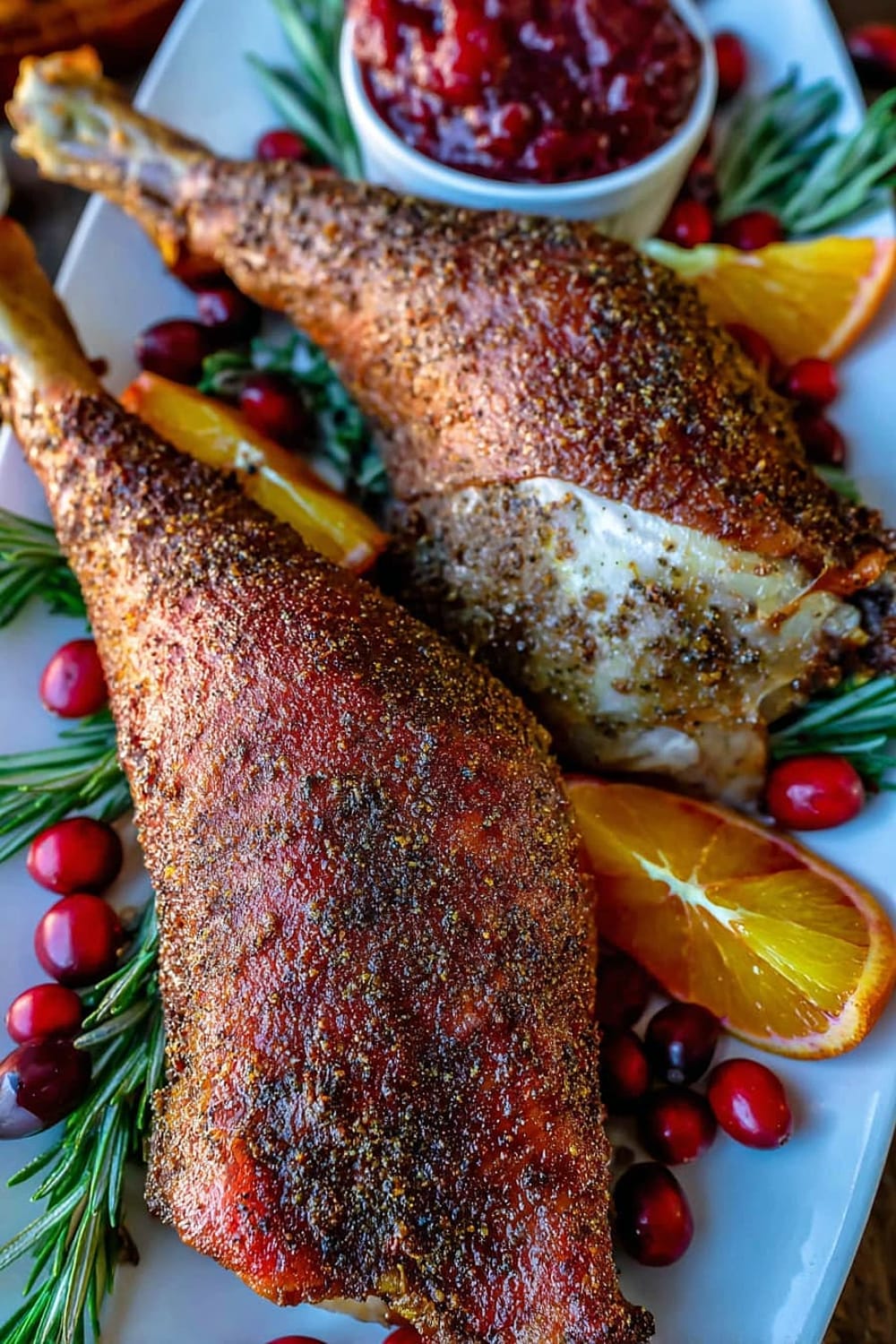
Nothing says “I know what I’m doing” quite like pulling perfectly smoked turkey legs off the grill that look like they came straight from a Renaissance fair, but taste way better than anything you’d get at a medieval theme park.

These aren’t your average turkey legs – we’re talking about fall-off-the-bone tender meat with crispy, golden skin that crackles when you bite into it, all infused with that deep, smoky flavor that only comes from low and slow cooking.
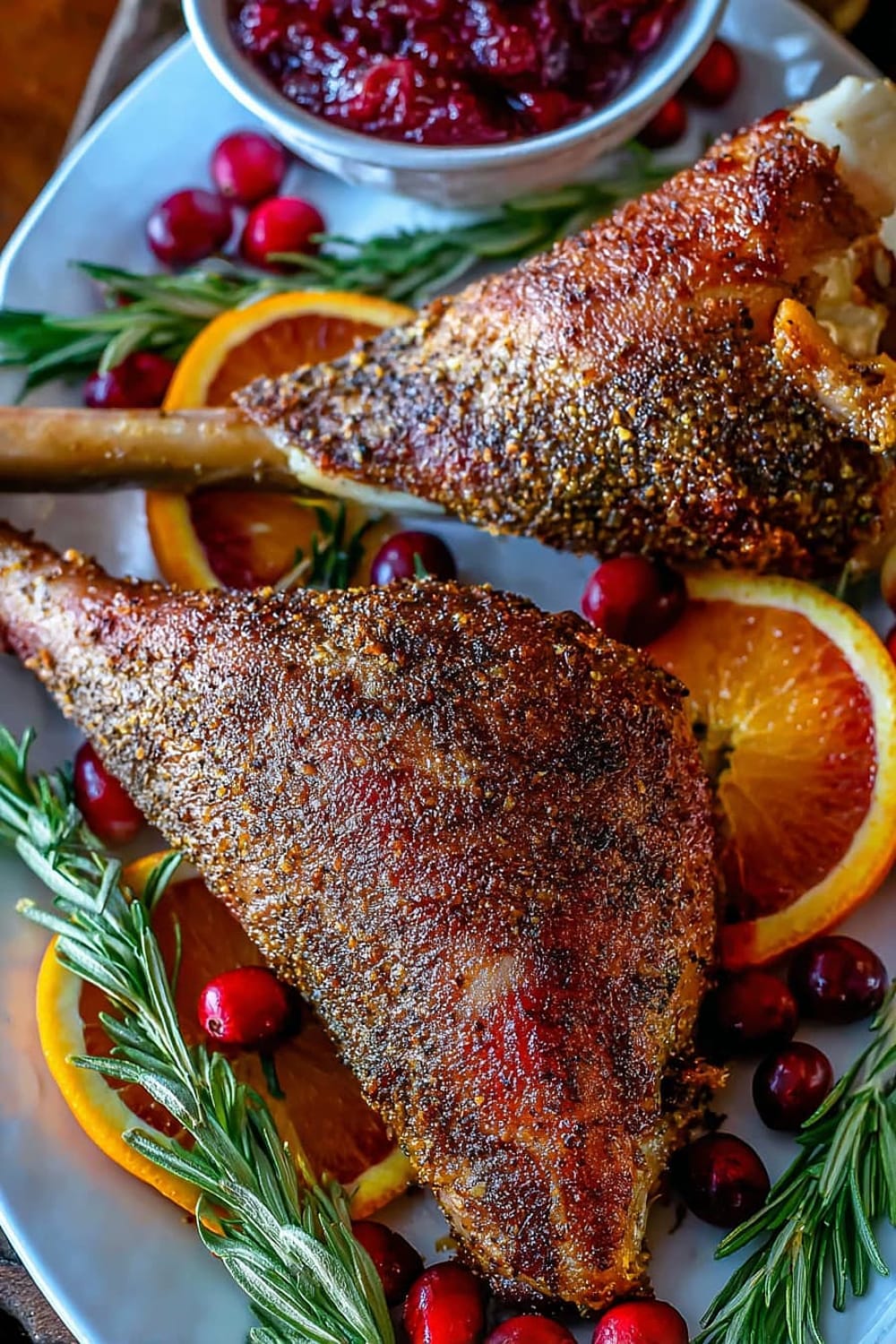
The secret weapon here is the apple cider brine that transforms these turkey legs from potentially dry disappointments into juicy, flavorful masterpieces that’ll have your neighbors “accidentally” wandering over around dinnertime.
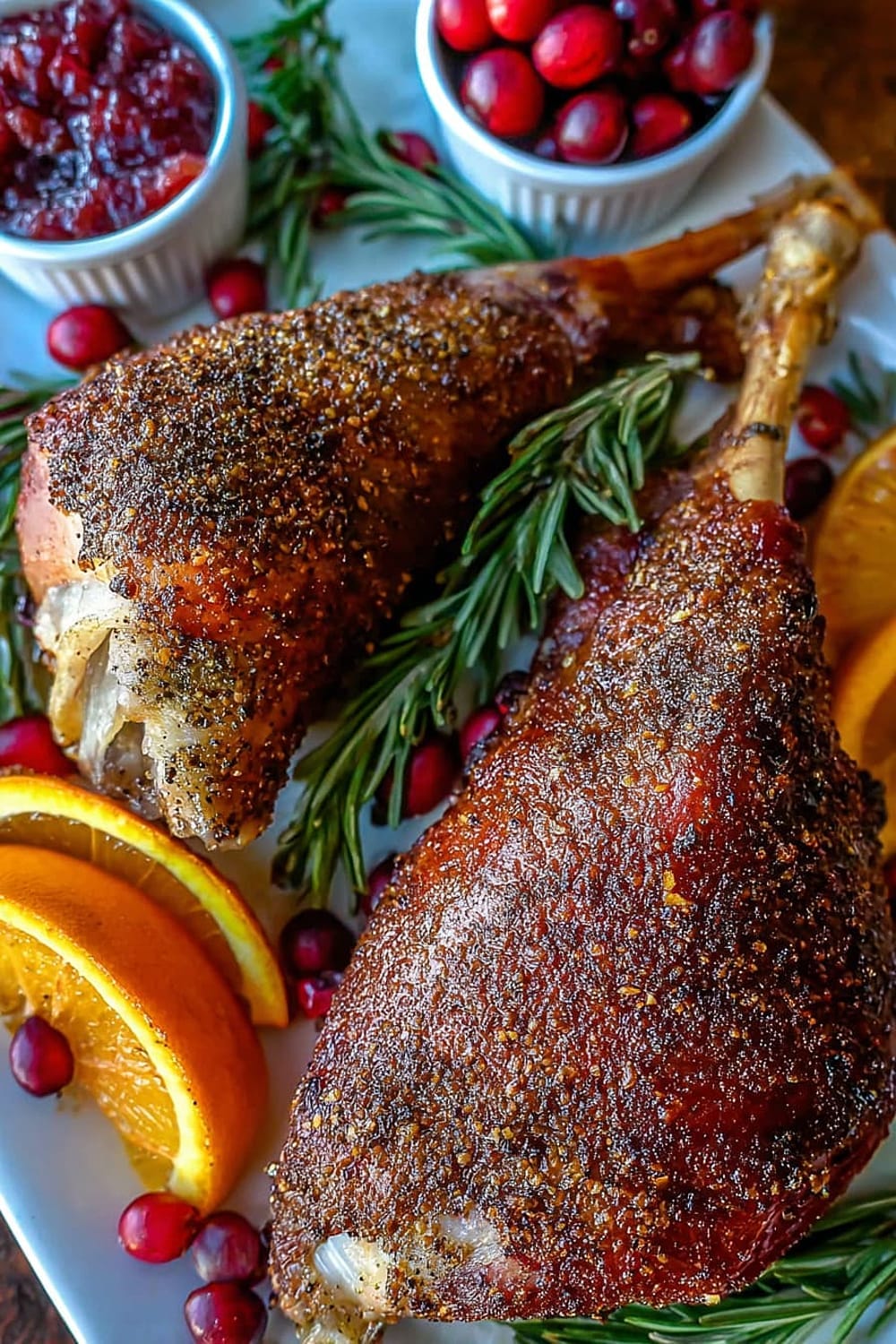
Fair warning: making these will officially designate you as the person everyone calls when they need to bring something impressive to a potluck, and honestly, that’s not the worst reputation to have.
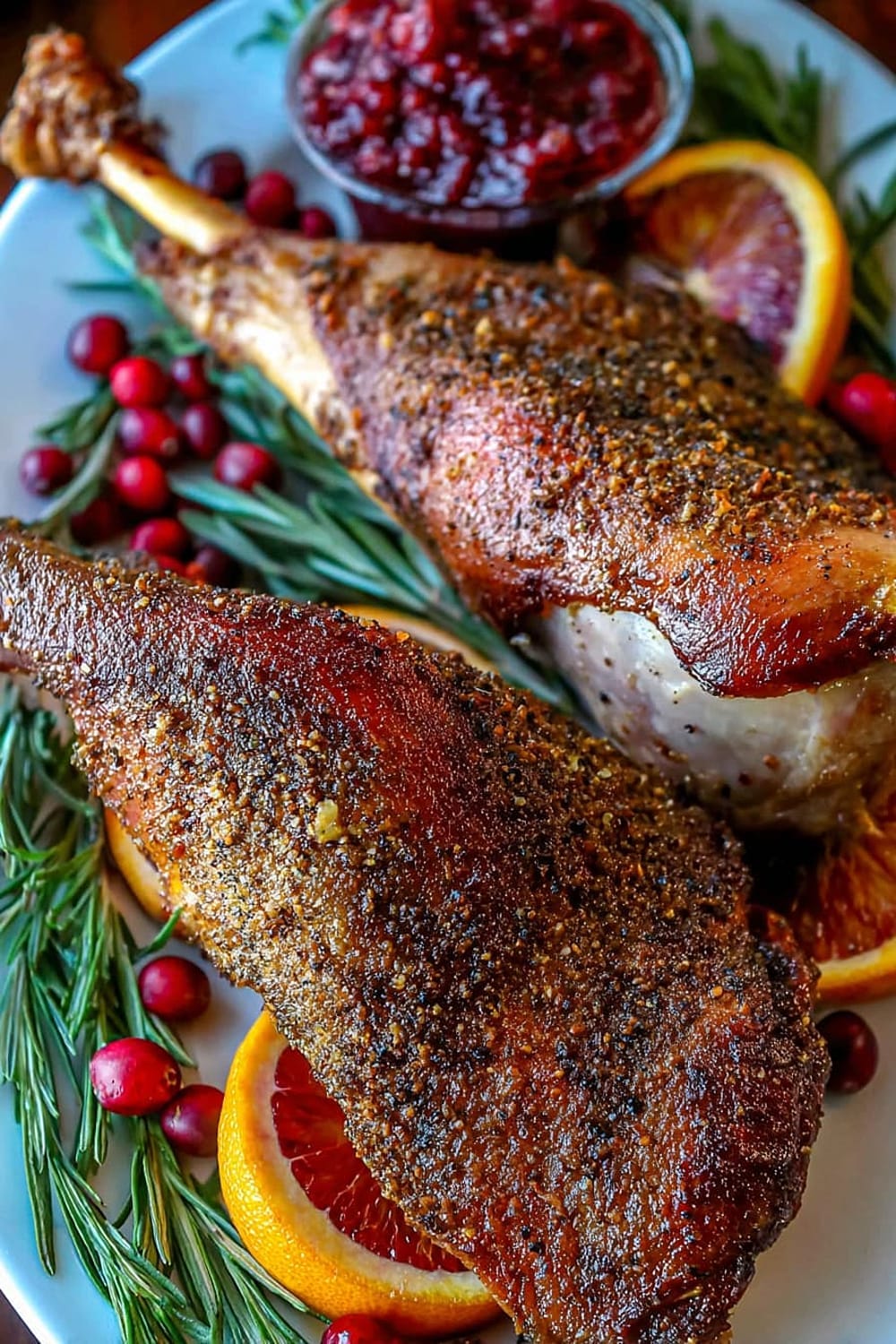
The best part is that while these look and taste like you spent all day babying them, the smoker does most of the heavy lifting while you sit back and accept compliments.
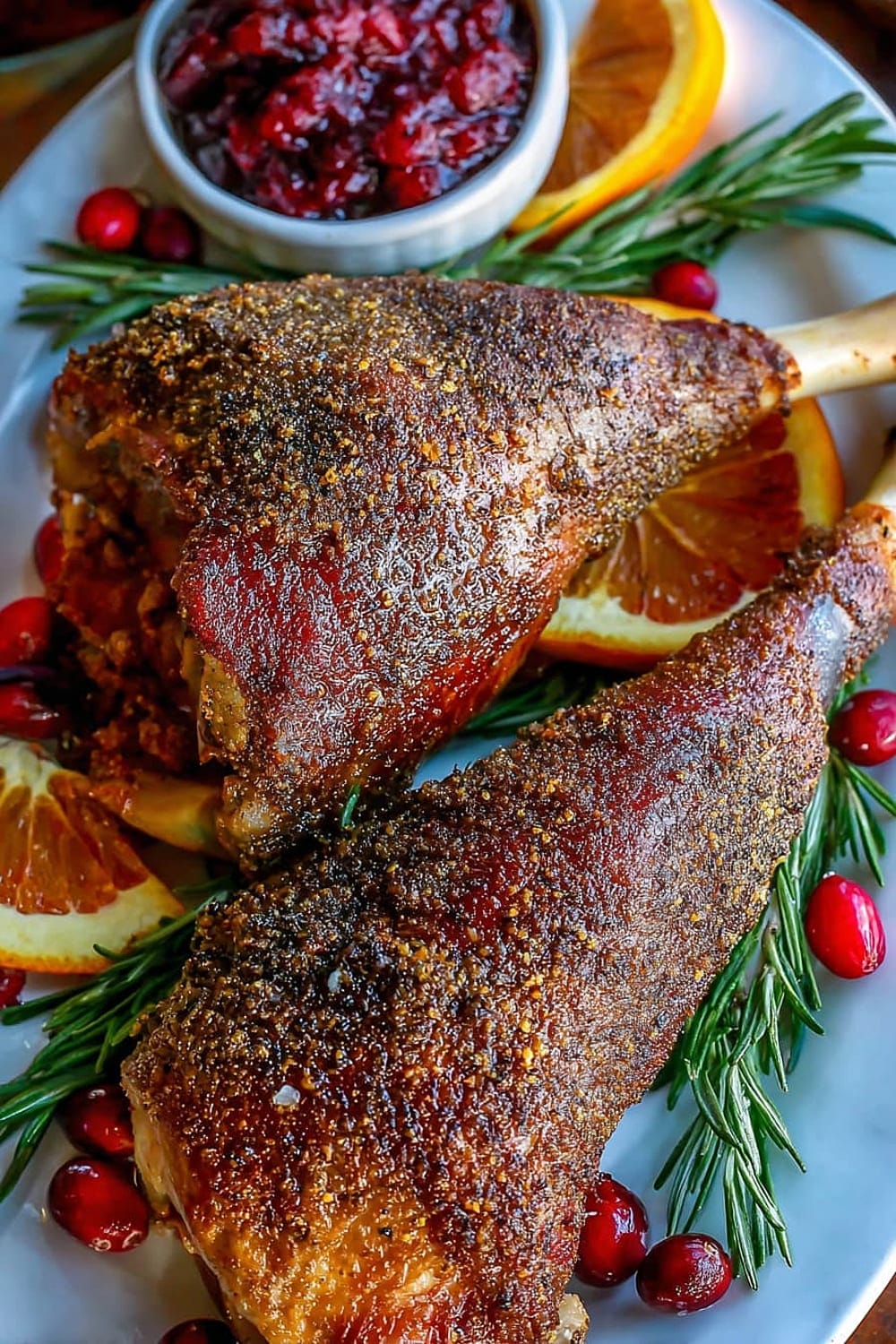
Get ready to become the turkey leg legend of your friend group – it’s a title that comes with great responsibility and even greater bragging rights.
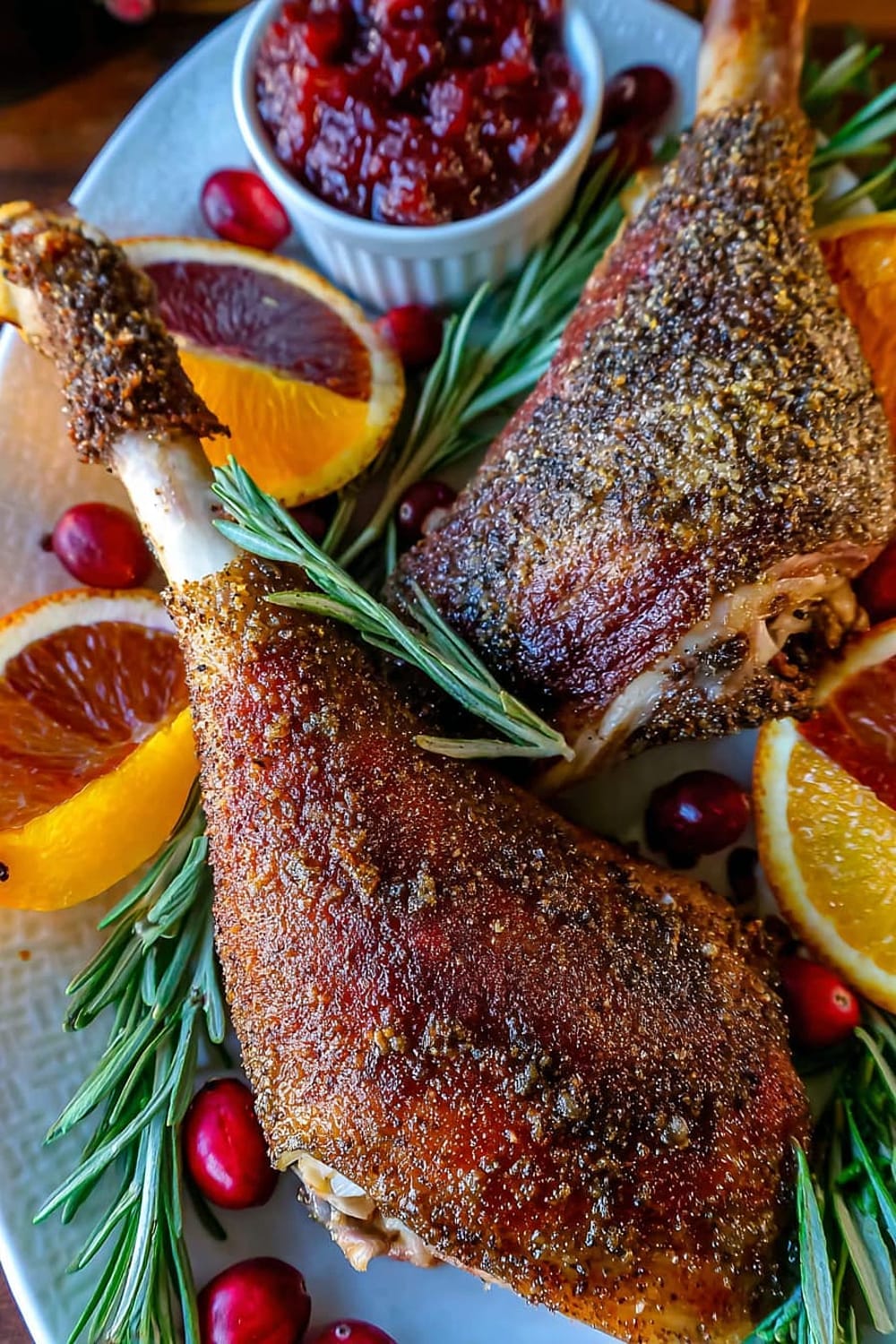
Ingredients
For the Turkey
- 4 large turkey legs (about 1-1.5 pounds each)
- 2 tablespoons olive oil (extra virgin for best flavor)
- 1 /2 cup poultry dry rub or your favorite BBQ dry rub
- 1 /4 cup butter, melted (grass-fed for premium results)
For Brining
- 1 batch apple cider brine (prepared according to recipe instructions)
Instructions
Apple Cider Wet Brine
- 1 Prepare the apple cider wet brine according to the recipe instructions in a large stainless steel pot on the stove, ensuring all salt and sugar dissolve completely. Let the brine cool to room temperature (about 70°F/21°C) before using – hot brine will start cooking the meat and ruin the texture.
- 2 Place the turkey legs in a large food-safe container or heavy-duty brining bag and add the cooled wet brine, making sure the legs are completely submerged. Place in the refrigerator and brine for 2-12 hours – longer brining times result in more flavorful, tender meat.
Preparation for Smoking
- 3 Remove the turkey legs from the wet brine and discard the brine mixture completely. Pat each turkey leg thoroughly dry with paper towels – any remaining moisture will prevent the skin from crisping properly during smoking.
- 4 Lightly coat each turkey leg with olive oil using your hands or a silicone brush, then season evenly on all sides with the BBQ dry rub, making sure to work the seasoning under the skin and into all the crevices for maximum flavor penetration.
Smoking Instructions
- 5 Preheat your smoker to 225°F (107°C) and set up for indirect heat cooking. If using wood chips, choose apple, hickory, or cherry wood for complementary flavors that won’t overpower the turkey.
- 6 Place the seasoned turkey legs directly onto the grill grates, leaving space between each leg for proper air circulation. Smoke for 45 minutes without opening the smoker – resist the urge to peek, as this releases valuable heat and smoke.
- 7 After 45 minutes, begin basting the turkey legs with melted butter using a silicone basting brush every 30 minutes. Continue smoking until the legs reach an internal temperature of 155°F (68°C) when measured with an instant-read thermometer in the thickest part of the thigh, typically 1.5-2 hours total.
- 8 Increase the smoker temperature to 425°F (218°C) to crisp the skin and finish cooking. Cook until the internal temperature reaches 175°F (79°C) – this final high-heat step ensures crispy skin while bringing the meat to perfect doneness.
- 9 Remove the turkey legs from the smoker and let them rest on a cutting board for 10-15 minutes before serving. This resting period allows the juices to redistribute throughout the meat, ensuring maximum tenderness and flavor in every bite.
Recommended Equipment and Kitchen Tools
Essential Tools (for best results)
- Instant-read thermometer – absolutely critical for food safety and perfect doneness, as turkey legs are thick and cooking times can vary
- Large stainless steel pot – needed for preparing the apple cider brine and ensuring even cooling
- Silicone basting brush – heat-resistant and easy to clean, perfect for applying melted butter during smoking
- Heavy-duty brining bag or large container – ensures turkey legs stay completely submerged during the brining process
Helpful Upgrades
- Digital probe thermometer – allows you to monitor internal temperature without opening the smoker, maintaining consistent heat
- Cast iron grill grates – retain heat better than standard grates and create beautiful sear marks on the skin
- Wood chip soaker box – if your smoker doesn’t have a built-in wood chip tray, this keeps chips smoking longer
Nice-to-Have Options
- Kitchen scale – for precise measurements when scaling the dry rub recipe up or down
- Aluminum foil pans – useful for catching drippings that can be turned into gravy later
- Long-handled tongs – makes it easier to handle large turkey legs safely on a hot smoker
Recipe Variations and Dietary Modifications
Spice Rub Variations
- Cajun-style: Replace poultry rub with 2 tablespoons paprika, 1 tablespoon cayenne, 1 tablespoon garlic powder, 1 teaspoon oregano
- Mediterranean blend: Use 2 tablespoons dried rosemary, 1 tablespoon thyme, 1 tablespoon garlic powder, 1 teaspoon lemon zest
- Asian-inspired: Combine 2 tablespoons five-spice powder, 1 tablespoon ginger powder, 1 teaspoon sesame seeds
Brine Alternatives
- Beer brine: Replace apple cider with 2 bottles of lager beer plus 1/2 cup brown sugar and standard brine seasonings
- Buttermilk brine: Use 4 cups buttermilk, 1/4 cup salt, 2 tablespoons honey for extra tender, tangy results
- Herb brine: Add 4 sprigs fresh thyme, 2 bay leaves, 1 sliced lemon to the apple cider brine
Cooking Method Adaptations
- Oven-roasted version: After brining and seasoning, roast at 325°F (163°C) for 2-2.5 hours until 175°F (79°C) internal temperature
- Grilled finish: Smoke to 155°F (68°C), then finish on direct heat grill for 10-15 minutes for extra crispy skin
- Slow cooker adaptation: After brining, cook on low for 6-8 hours, then broil for 5 minutes to crisp skin
Nutritional Information and Health Benefits
Key Nutritional Highlights
Each serving provides approximately 1,139 calories with a robust 85 grams of protein, making these turkey legs an excellent choice for those following high-protein diets or looking to build muscle mass. The 45 grams of fat come primarily from the skin and added olive oil, providing essential fatty acids and fat-soluble vitamins. Carbohydrate content remains minimal at under 5 grams per serving, making this naturally keto-friendly.
Health Benefits of Main Ingredients
Turkey is an exceptional source of selenium, providing over 100% of daily needs per serving, which supports thyroid function and acts as a powerful antioxidant. The B-vitamin complex in turkey, particularly niacin and B6, supports energy metabolism and nervous system function. Apple cider in the brine contributes beneficial compounds like quercetin, an anti-inflammatory antioxidant. The olive oil provides monounsaturated fats and vitamin E, supporting heart health and reducing inflammation.
Dietary Considerations
This recipe is naturally gluten-free, dairy-free (if butter is omitted), and low-carb. The high protein content makes it suitable for paleo and keto diets. Those watching sodium should note that brining adds significant sodium content, though much is discarded with the brine. The cooking method preserves most nutrients while the low-and-slow smoking process doesn’t require additional unhealthy fats.
Smart Swaps and Ingredient Substitutions
Oil and Fat Substitutions:
- Olive oil → Avocado oil (higher smoke point, neutral flavor) or melted coconut oil (adds subtle sweetness)
- Butter for basting → Ghee (dairy-free, higher smoke point) or olive oil with herbs (dairy-free option)
Seasoning Alternatives:
- Poultry dry rub → Equal parts paprika, garlic powder, onion powder, thyme, salt, and pepper for homemade version
- Store-bought rub → 2 tablespoons brown sugar, 1 tablespoon each: paprika, chili powder, cumin, salt for smoky-sweet profile
Brine Modifications:
- Apple cider brine → Basic salt brine (1 cup salt per gallon water) if apple cider isn’t available
- Long brining time → Dry brine overnight with 2 tablespoons salt per leg if short on time
Budget-Friendly Swaps:
- Turkey legs → Chicken leg quarters (reduce cooking time by 30-45 minutes, same internal temperature target)
- Premium dry rub → Homemade blend using basic spices saves 50-70% of cost
- Wood chips → Fruit wood from pruned trees (apple, cherry) if available locally
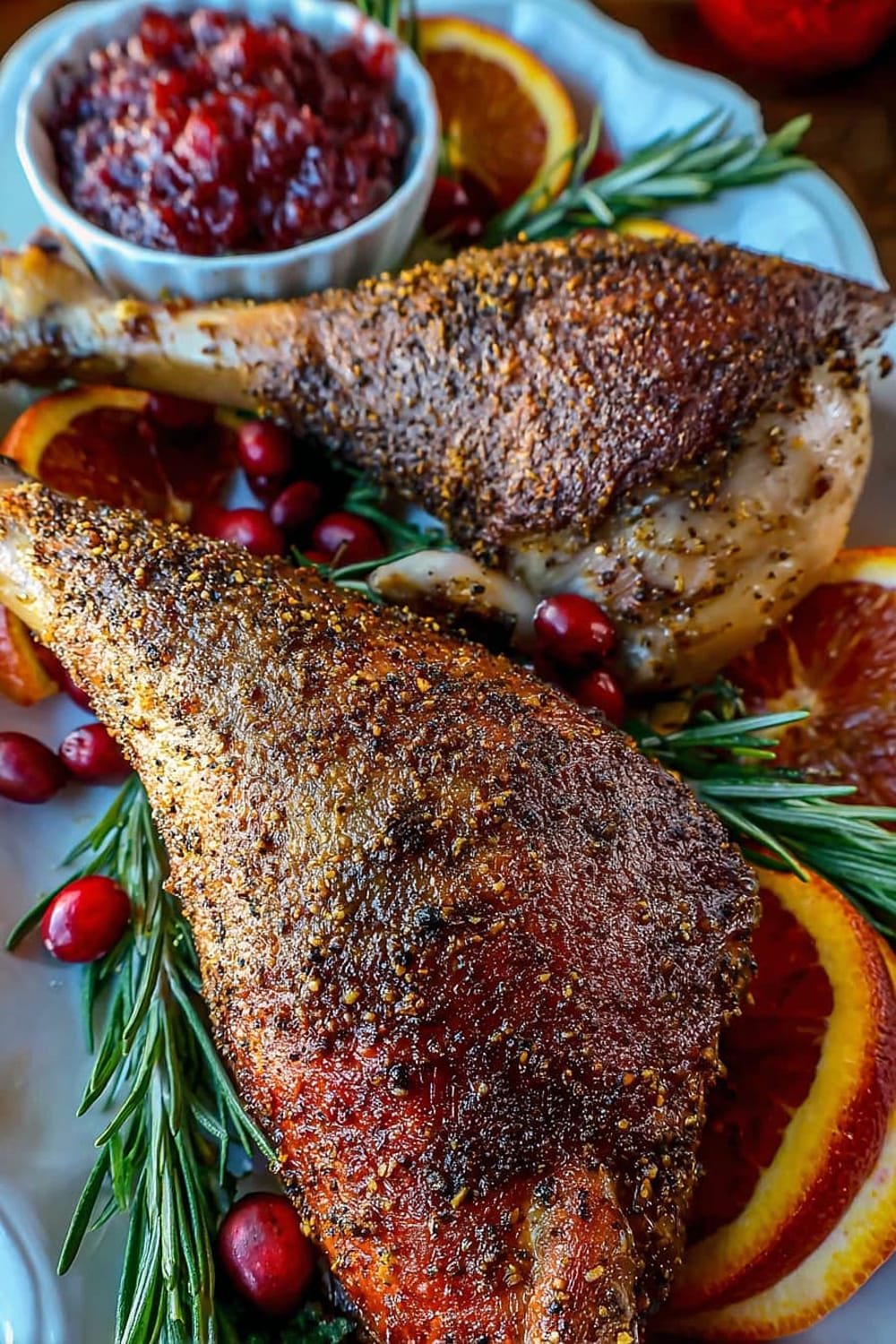
Make It Diabetes-Friendly
Carb Reduction Strategies:
- Skip added sugars in dry rub – replace brown sugar with erythritol or stevia blend at 1:1 ratio for sweetness without blood sugar impact
- Modify brine recipe by reducing or eliminating apple cider sugar content – use sugar-free apple cider or plain apple cider vinegar with water
- Focus on herb and spice flavors rather than sweet components in seasoning blends
Portion and Pairing Guidelines:
- Recommended serving: 1 turkey leg (about 6-8 oz meat) provides 0-2g net carbs depending on rub ingredients
- Pair with low-carb sides: Roasted Brussels sprouts, cauliflower mash, or green bean almondine to keep total meal under 15g carbs
- Timing tip: Consume with healthy fats like the natural skin and olive oil to slow any carb absorption and maintain stable blood sugar
Enhanced Nutritional Profile:
- High protein content (85g) helps stabilize blood sugar and promotes satiety for 4-6 hours
- Natural fats support insulin sensitivity when consumed as part of balanced meal
- Zero added sugars when modifications are made to rub and brine recipes
Total Carb Reduction: Modified version contains less than 3g net carbs per serving compared to traditional recipes with 8-12g carbs
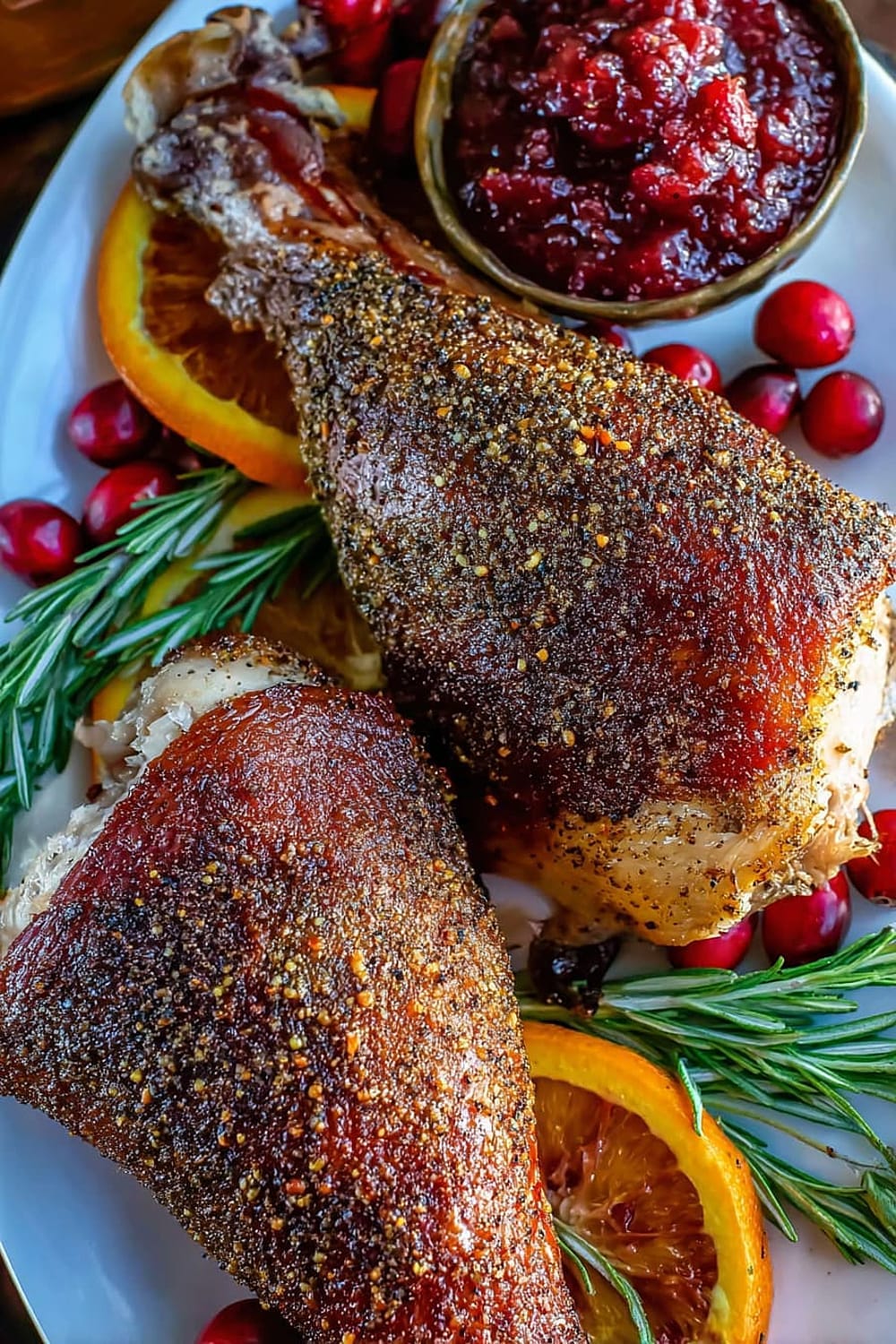
Perfect Pairing Suggestions
Beverage Pairings
A bold red wine like Zinfandel or Syrah complements the smoky, rich flavors beautifully, while craft beer enthusiasts should reach for a porter or brown ale that won’t compete with the turkey’s complexity. For non-alcoholic options, sparkling apple cider echoes the brine flavors, or try unsweetened iced tea with lemon to cut through the richness. Bourbon-based cocktails like an Old Fashioned pair exceptionally well with the smoky elements.
Side Dish Recommendations
Creamy coleslaw provides the perfect cool, crunchy contrast to the rich, smoky meat, while roasted root vegetables like carrots, parsnips, and sweet potatoes complement the autumn flavors in the apple cider brine. Cornbread with honey butter is a classic pairing that soaks up the delicious drippings, and grilled asparagus or broccolini adds a fresh, green element that balances the meal’s richness.
Complete Meal Ideas
Start with bacon-wrapped jalapeño poppers as appetizers to build on the smoky theme, then serve the turkey legs as the centerpiece alongside mac and cheese and collard greens with smoked ham hock. For dessert, bourbon pecan pie or apple crisp continues the fall flavor profile. This combination works perfectly for tailgating, backyard barbecues, or casual dinner parties where impressive presentation meets comfortable, hands-on eating.
Pro Tips and Troubleshooting
Temperature Management Secrets
The key to perfect turkey legs is maintaining consistent 225°F (107°C) during the smoking phase – invest in a dual-probe thermometer to monitor both smoker and meat temperatures simultaneously. If your smoker runs hot, place a water pan underneath the turkey legs to create humidity and prevent overcooking. Don’t rush the process – low and slow is essential for breaking down the tough connective tissues in the legs.
Common Mistakes to Avoid
Skipping the brine is the biggest error – turkey legs are naturally tough and need that moisture and flavor infusion. Opening the smoker too frequently drops the temperature and extends cooking time significantly. Not drying the skin thoroughly after brining results in rubbery, unappetizing skin instead of the crispy exterior you want.
Storage and Reheating
Store leftover turkey legs in the refrigerator for up to 4 days or freeze for up to 3 months. Reheat in a 300°F (149°C) oven wrapped in aluminum foil for 20-25 minutes, then unwrap and broil for 2-3 minutes to re-crisp the skin. Avoid microwaving as it makes the skin soggy and heats unevenly.
Make-Ahead Strategy
Brine the turkey legs up to 24 hours in advance, then pat dry and season the morning of cooking. The dry rub actually improves when applied several hours before smoking, allowing the spices to penetrate deeper into the meat.
These smoked turkey legs represent everything great about outdoor cooking – they’re impressive enough for special occasions but simple enough for a weekend experiment, and the results speak for themselves with every smoky, succulent bite.